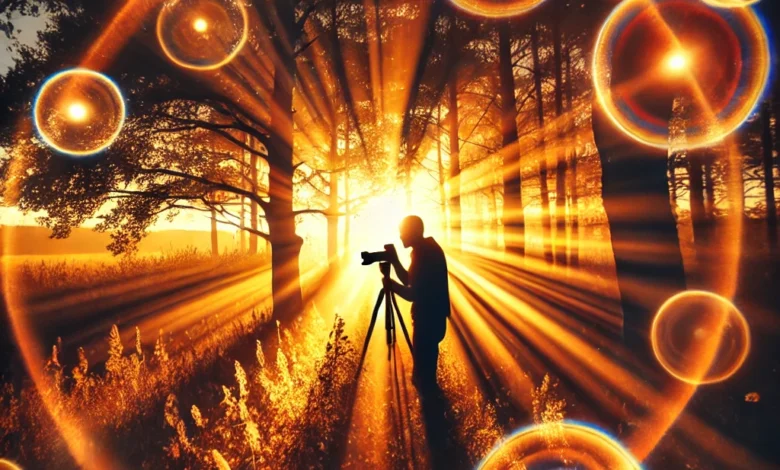Capturing Light Artfully: The Magic of Photeeq Lens Flare

Photography is the art of capturing light—and among the many ways light can be manipulated, few are as visually enchanting as lens flare. Specifically, photeeq lens flare has become a favorite among photographers and digital artists for the soft, glowing aesthetic it introduces into images. This visual element is more than just a side effect of bright light; when used correctly, it becomes a powerful storytelling tool that transforms an ordinary photograph into something extraordinary.
In this article, we explore the world of photeeq lens flare, how it works, why it’s popular among creators, and how you can incorporate it effectively into your photography.
What Is Photeeq Lens Flare?
Lens flare generally occurs when a bright light source—like the sun or a strong artificial light—enters the camera lens and reflects internally between the lens elements. This results in a visual artifact, often seen as glowing circles, streaks, or haze across the image. While some may view flare as an error, photeeq lens flare is intentionally used to enrich images with an ethereal, atmospheric quality.
The photeeq lens flare is known for its unique softness and warm tones, offering a dreamy touch that enhances the emotion and mood of a photo. It’s commonly used in portrait, landscape, and urban photography to add depth and visual intrigue.
Why Photographers Love Photeeq Lens Flare
The appeal of photeeq lens flare lies in its artistic value. When strategically used, it can elevate a photograph’s mood, focus, and even narrative. Here’s why many photographers include it in their creative toolkit:
1. Atmospheric Enhancement
Photeeq lens flare creates a soft, glowing ambiance. Whether it’s sunlight filtering through trees or a city skyline at dusk, the resulting glow adds a magical quality to the image.
2. Visual Storytelling
Lens flare can subtly guide the viewer’s eye toward a subject or key area in the composition. This helps structure the visual flow of the image and enhances storytelling.
3. Dynamic Depth
The layered light effects introduced by lens flare add a sense of dimension, making images feel more immersive and alive.
4. Color Enrichment
Often, photeeq lens flare brings out warm golds or cool blues depending on the light source. These subtle color boosts can improve harmony and create an appealing color palette.
How to Use Photeeq Lens Flare in Photography
Whether you’re a beginner or a seasoned photographer, here are practical tips to help you harness the full potential of photeeq lens flare:
1. Shoot During the Right Lighting Conditions
Natural flare is best captured during golden hour—the short window after sunrise or before sunset. At this time, the sunlight is soft, warm, and at a low angle, which produces the most pleasing flare effects. Shooting into the sun or placing the light source just outside the frame can yield beautiful results.
2. Experiment with Camera Angles
Altering the camera’s angle affects the way light enters the lens, which changes the appearance of the flare. Move your camera slightly up or down, or tilt it sideways to explore different effects. Don’t be afraid to try unconventional perspectives.
3. Use Filters for Extra Control
Attaching filters like UV or polarizing filters to your lens can modify the intensity and pattern of the flare. Some filters can soften the flare, while others might enhance it, giving you greater artistic control over the final image.
4. Post-Processing with Software
If natural lighting conditions aren’t available, digital post-processing tools like Photoshop or Lightroom can simulate photeeq lens flare. Use overlays, brushes, or built-in flare effects to add subtle light streaks or glow to your image. The key is to keep it believable—too much can make the image look unnatural.
5. Maintain Strong Composition
Even when using lens flare, your composition should remain strong. Use standard techniques like the rule of thirds, leading lines, and symmetry to ensure the subject stays prominent and the flare complements the scene rather than distracting from it.
The Science Behind Photeeq Lens Flare
Understanding the mechanics of lens flare helps you use it more effectively. A camera lens is made up of multiple glass elements. When bright light hits the lens at a certain angle, it bounces internally, creating reflections that appear as lens flare. The number of elements, their coating, and curvature all influence how flare appears.
In photeeq lens flare, the goal is to use this phenomenon intentionally, either through natural light or editing, to emphasize beauty and emotion in a photo. By carefully selecting the angle, brightness, and subject positioning, you can produce stunning visual results.
Common Mistakes to Avoid
- Overusing flare: Too much flare can wash out details or overwhelm the subject.
- Ignoring exposure: Letting too much light in can result in blown-out highlights.
- Forgetting the story: Lens flare should enhance, not replace, the narrative of your image.
FAQs about Photeeq Lens Flare
Q1: What makes photeeq lens flare different from regular lens flare?
A: Photeeq lens flare typically refers to a stylized or enhanced version of lens flare, often characterized by soft edges, subtle color transitions, and artistic application, whether captured naturally or added in post-processing.
Q2: Can I use photeeq lens flare on mobile devices?
A: Yes, many mobile photography apps offer photeeq lens flare effects that you can add during editing. While not as precise as DSLR methods, they still offer creative flexibility.
Q3: Is it better to add lens flare naturally or during editing?
A: Both methods have value. Natural flare gives authenticity, while editing offers full control. Depending on your vision and shooting conditions, you might choose one over the other or even combine both.
Q4: Does photeeq lens flare work for all types of photography?
A: While it’s most commonly used in portraits, landscapes, and street photography, photeeq lens flare can be applied in various genres. The key is using it tastefully and contextually.
Q5: What kind of lens is best for capturing photeeq lens flare?
A: Prime lenses with fewer elements often produce more distinctive flare patterns. However, modern zoom lenses can also create beautiful flares, especially if they lack anti-reflective coatings.
Final Thoughts
Photeeq lens flare is a powerful visual tool that can transform simple scenes into emotionally rich and visually captivating images. Whether you use it through natural lighting techniques or digital enhancements, the key lies in thoughtful composition and understanding how light interacts with your lens. By practicing and experimenting, you can master this technique and let light tell your story in a more compelling way.



